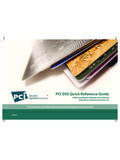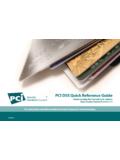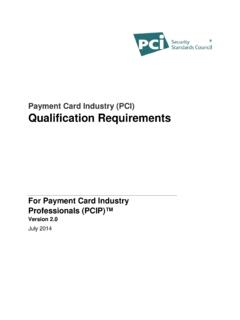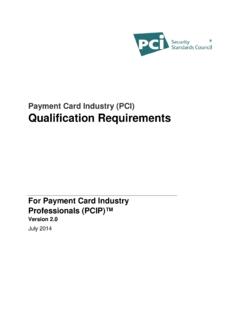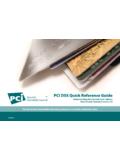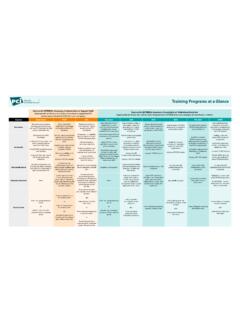Transcription of Payment Card Industry (PCI) PIN Transaction …
1 Payment card Industry (PCI) PIN Transaction Security (PTS) Point of Interaction (POI) Modular Security Requirements Version June 2013 Payment card Industry PTS POI Security Requirements June 2013 Copyright 2013 PCI Security Standards Council LLC Page 1 Document Changes Date Version Description February 2010 RFC version April 2010 Public release October 2011 Clarifications and errata, updates for non-PIN POIs, encrypting card readers February 2013 RFC version June 2013 Public release Payment card Industry PTS POI Security Requirements June 2013 Copyright 2013 PCI Security Standards Council LLC Page 2 Table of Contents Document Changes .. 1 About This Document .. 4 Purpose .. 4 Scope of the Document.
2 4 Main Differences from Previous Version .. 5 PTS Approval Modules Selection .. 6 Foreword .. 7 Evaluation Domains .. 7 Device Management .. 7 Modular approach .. 7 Related Publications .. 8 Required Device Information .. 9 Optional Use of Variables in the Identifier ..11 Evaluation Module Information ..12 POS Terminal Integration and Core Requirements Modules ..12 Open Protocols Module Protocol Declaration Form ..13 Secure Reading and Exchange of Data Module ..13 Evaluation Module Evaluation Module 1: Core Requirements ..15 A Core Physical Security Requirements ..15 B Core Logical Security Requirements ..18 C Online PIN Security Requirement ..21 D Offline PIN Security Requirements ..21 Evaluation Module 2: POS Terminal integration.
3 23 E POS Terminal Integration Security Requirements ..23 Evaluation Module 3: Open Protocols ..26 F Discovery ..26 G Vulnerability Assessment ..27 H Vendor Guidance ..28 I Operational Testing ..29 J Maintenance ..31 Evaluation Module 4: Secure Reading and Exchange of Data (SRED) ..32 K Account Data Protection ..32 Evaluation Module 5: Device Management Security Requirements ..36 L During Manufacturing ..36 M Between Manufacturer and Facility of Initial Key Loading or Facility of Initial Deployment ..38 Compliance Declaration General Information Form A ..40 Compliance Declaration Statement Form B ..41 Compliance Declaration Exception Form C ..42 Payment card Industry PTS POI Security Requirements June 2013 Copyright 2013 PCI Security Standards Council LLC Page 3 Appendix A: Requirements Applicability Matrix.
4 43 Appendix B: Applicability of Requirements ..44 Glossary ..48 Payment card Industry PTS POI Security Requirements June 2013 Copyright 2013 PCI Security Standards Council LLC Page 4 About This Document Purpose The purpose of this document is to provide vendors with a list of all the security requirements against which their product will be evaluated in order to obtain Payment card Industry (PCI) PIN Transaction Security (PTS) Point of Interaction (POI) device approval. Version 3 introduced significant changes in how PCI will be evaluating PIN and non-PIN acceptance POI terminals. PCI no longer maintains three separate security evaluation programs (point-of-sale PIN entry device (PED), encrypting PIN pad (EPP), and unattended Payment terminal (UPT)).
5 Instead PCI provides and supports one set of modular requirements, which covers all product options. This change was reflected in our renaming of this document to be the Modular Security Requirements. The layout of the document was also changed to enable vendors to select the appropriate requirements that match the product they are submitting for evaluation. This document supports the submission of products under the following categories: PED or UPT POI devices: Complete terminals that can be provided to a merchant as-is to undertake PIN-related transactions . This includes attended and unattended POS PIN-acceptance devices. Non-PIN acceptance POI devices evaluated for account data protection Encrypting PIN pads that require integration into POS terminals or ATMs.
6 Overall requirements for unattended PIN-acceptance devices currently apply only to POS devices and not to ATMs. Secure components for POS terminals: These products also require integration into a final solution to provide PIN transactions . Examples are OEM PIN entry devices and secure (encrypting) card readers. This version 4 additionally provides for: Submission by the vendor for assessment and publication on the PCI website of a user-available security policy addressing the proper use of the POI in a secure fashion, as further delineated in requirement B20. Greater granularity and robustness of the underlying PCI-recognized laboratory test procedures for compliance validation of a device to these requirements as detailed in the Derived Test Requirements.
7 Scope of the Document This document is part of the evaluation support set that laboratories require from vendors (details of which can be found in the PCI PTS Program Manual) and the set may include: A companion PCI PTS Questionnaire (where technical details of the device are provided) Product samples Technical support documentation Payment card Industry PTS POI Security Requirements June 2013 Copyright 2013 PCI Security Standards Council LLC Page 5 Upon successful compliance testing by the laboratory and approval by the PCI SSC, the PCI PTS POI device (or a secure component) will be listed on the PCI SSC website. Commercial information to be included in the Council s approval must be provided by the vendor to the test laboratory using the forms in the Evaluation Module Information section of this document.
8 Main Differences from Previous Version This document is an evolution of the previous versions and supports a number of new features in the evaluation of POI devices: The reordering of the Core Physical Security Requirements The restructuring of the Open Protocols module The addition of a requirement for the vendor to provide a user-available security policy that will facilitate implementation of an approved POI device in a manner consistent with these requirements, including information on key-management responsibilities, administrative responsibilities, device functionality, identification, and environmental requirements Payment card Industry PTS POI Security Requirements June 2013 Copyright 2013 PCI Security Standards Council LLC Page 6 PTS Approval Modules Selection The graph below gives a preliminary view of which evaluation modules should apply.
9 Based on the product undergoing an evaluation. This only reflects applicability of modules. Appendix B: Applicability of Requirements makes further refinement at the requirement level. Payment card Industry PTS POI Security Requirements June 2013 Copyright 2013 PCI Security Standards Council LLC Page 7 Foreword The requirements set forth in this document are the minimum acceptable criteria for the Payment card Industry (PCI). The PCI has defined these requirements using a risk-reduction methodology that identifies the associated benefit when measured against acceptable costs to design and manufacture POI devices. Thus, the requirements are not intended to eliminate the possibility of fraud, but to reduce its likelihood and limit its consequences.
10 Evaluation Domains Device characteristics are those attributes of the device that define its physical and its logical (functional) characteristics. The physical security characteristics of the device are those attributes that deter a physical attack on the device, for example, the penetration of the device to determine its key(s) or to plant a sensitive data-disclosing bug within it. Logical security characteristics include those functional capabilities that preclude, for example, allowing the device to output a clear-text PIN-encryption key. The evaluation of physical security characteristics is very much a value judgment. Virtually any physical barrier can be defeated with sufficient time and effort. Therefore, many of the requirements have minimum attack calculation values for the identification and initial exploitation of the device based upon factors such as attack time, and expertise and equipment required.
